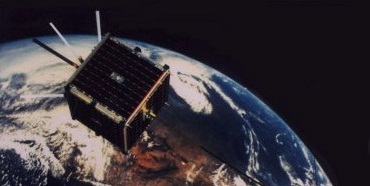

![]()
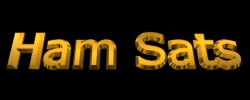
![]()
Amateur Satellites & Other Space Related Material
One of my favorite ham radio activities includes the operation of the amateur radio satellites. My favorite satellites are the low orbiting "Mode A" birds. These are satellites that were constructed and launched by the Russians. These require that an uplink signal be transmitted on 2 meter CW or S.S.B. and the downlink is received on 10 meter CW or S.S.B.
The equipment required for the Mode A satellites is minimal and need not be complex or expensive. A low power (QRP) 2 meter transmitter and a 10 meter receiver are all that are required - especially if using CW. Many stations have even used their 2 meter FM handhelds as CW transmitters. They have used the PTT (push to talk) button as a CW key for the uplink and received the downlink on a simple 10 meter receiver.
"CW
and QRP - A
 Combination!"
Combination!"
RS-15 Spacecraft Information
Name: Radio
Sputnik (RS) 15
NASA Catalog Number: 23440
Launched: December 16, 1994
Launch vehicle: Modified SS-19 missile
Launch location: Baykonur Cosmodrome
Weight: 70 kg
Orbit: Polar LEO (Low Earth Orbit) - 2000 km altitude
Inclination: 64.6 degrees
Period: 128 Minutes
Modes: A
Beacons: 29.3525 and 29.3987 MHz (CW)
Features:
Linear Transponder:
RS-12/13 Spacecraft Information
Name: Radio Sputnik
(RS) 12/13
NASA Catalog Number: 21089
Launched: February 5, 1991
Primary Spacecraft: COSMOS 2123 - Russian Navigation Satellite
Orbit: Polar LEO (Low Earth Orbit) - 1000 km altitude
Period: 105 Minutes
Modes: K, T, A, KT, KA
Beacons: 29.408, 29.454, 145.912, and 145.959 MHz (CW)
Features:
Linear Transponder:
I use a Kenwood TR-751A multi-mode 2 meter transceiver for the uplink transmitter and an Elecraft K2 for the downlink receiver. My antenna system consists of a homebrew 14 element cross-yagi for the 2 meter uplink signal and a wire dipole for the 10 meter downlink signal.
The ability to turn your antennas both left to right (azimuth), as well as up and down (elevation), is a big advantage if beam antennas are used. If you cannot get a hold of an elevation rotator for your antennas you can try mounting your beams at about a 30 degree angle. Computer programs which are offered as "Freeware" and "Shareware" are available to help an amateur locate and track these satellites. There are also many feature-packed higher priced commercial tracking programs available for finding the "birds".
I also enjoy working the low orbiting Japanese satellites such as FO-20 and FO-29. These satellites use 2 meters as the uplink frequency and 70 cm as the downlink. This is known as "Mode J". For mode J, I use my Kenwood TR-751A as the uplink radio and a Kenwood TR-851A UHF multi-mode transceiver as the downlink radio.
My 14 element 2 meter cross-yagi is used for the uplink signal on FO-20 and FO-29 and I use a homebrew vertical for the downlink on UHF. A good quality low noise pre-amp is a big help for the UHF receive signal.
FO-20 Spacecraft Information
Name:
Fuji-OSCAR-20 aka JAS-1b and Fuji-2
Callsign: 8J1JBS
NASA Catalog Number: 20480
Launched: February 7, 1990
Launch vehicle: Japanese H-I
Launch location: Tanegashima Space Center of NASDA, Tanegashima Island,
Japan
Weight: 50 kg
Orbit: Polar LEO (Low Earth Orbit)
Inclination: 99 degrees
Size: 44 cm wide x 47 cm high
Period: 112 minutes
Features:
Beacon
Digital Transponder - Mode JD
Analog Transponder - Mode JA
Note: FO-20 is permanently in the analog mode.
FO-29 Spacecraft Information
Name:
Fuji-OSCAR-29 aka Fuji-2 and JAS-2
Callsign: 8J1JCS
NASA Catalog Number: 24278
Launched: August 17, 1996
Launch vehicle: Japanese H-II No. 4
Launch location: Tanegashima Space Center of NASDA, Tanegashima Island,
Japan
Weight: 50 kg
Orbit: Polar LEO (Low Earth Orbit)
Inclination:
Size: 44 cm wide x 47 cm high
Period:
Features:
Beacon (100 milliWatt)
Digital Transponder - Mode JD (1 Watt)
Analog Transponder - Mode JA (1 Watt)
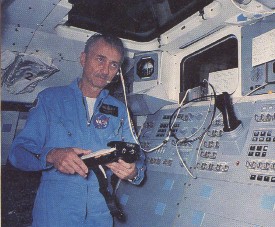
Astronaut
Owen Garriott, W5LFL, testing the
radio and antenna he used during the Space
Shuttle Columbia's STS-9 mission in 1983.
Astronaut Owen Garriott, W5LFL, was responsible for the first direct contact between an astronaut in space and earthbound ham radio operators. This took place during the Space Shuttle Columbia's STS-9 mission towards the end of 1983.
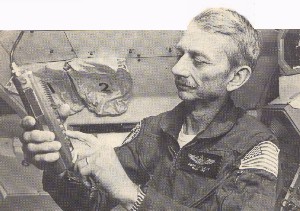
W5LFL and the 4 watt transceiver used.
Owen Garriott, W5LFL, used a 4 watt QRP transceiver to contact several hams around the world, including senator Barry Goldwater, K7UGA and King Hussein of Jordan, JY1. He began transmitting to Hams on November 30, 1983 at approximately 6 p.m. (M.T.), and continued to transmit until December 8, 1983. He was able to log nearly 7 hours of free operating time on the radio during the mission.
W5LFL Audio
(Click above)
Recorded by VE6QX
![]()
![]()
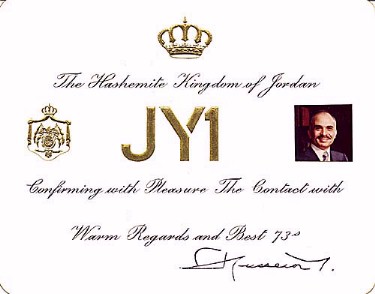
![]()
"During the winter of 1963, one of the most severe Pennsylvania winters on record, I spent many nights with my brother in his "Ham Shack". It was a cement block building without plumbing or heat, but with an electric line to power a Drake 2NT transmitter, a homemade vacuum tube receiver and a coil heater that barely kept our knees warm. The building squatted on the edge of our parents' property 200 feet from our house, and there we transfixed in silence, transcribing Morse code that beeped over the airwaves. We were urged by a thrill for signals from distant places, and ham radio station KN3VNZ was plastered with colorful postcard-sized QSLs from hams we'd contacted across the United States, Canada and elsewhere. (QSL is an abbreviation for cards exchanged after communication that verify contact time, date and frequency; they decorated our shack's gray walls.)
That we kept going through the coldest nights seems funny to me now, numbed toes and fingers for such private little pleasures. "CQ, CQ, CQ," the call for anyone to respond, was tapped out into the night on the 40-meter band as we hoped the antenna we erected the previous summer would catch some weak signal long enough for a QSL. Before our signals faded, we traded simple information: the time, date, weather, signal strength, the kind of equipment we had. Sometimes we were lucky enough to get Greenland, Brazil or California."
- Astronaut Owen Garriott, W5LFL -
![]()
SAREX, (The Space Amateur Radio Experiment) continues to operate from scheduled Shuttle missions whenever possible. Check the SAREX link below for more information!
The new International Space Station will also be operating several amateur radio modes on different ham bands when construction is further along.

The Cosmonauts aboard the MIR Space Station were also very active with ham radio. They sometimes were active on the space station using FM voice, Packet Radio (Packet Radio BBS) and they had begun using SSTV (Slow Scan TV) before the MIR Space Station was abandoned.
Here are some pictures transmitted by the Cosmonauts aboard the MIR Space Station and received by VE6EGN on the 144 MHz (2 meter) band. The slow scan television mode used to transmit the pictures below was Robot 36. The frequency used was 145.985 MHz using a Kenwood TM-733 transceiver with a Kenwood TM-V7A camera/sstv unit.
Received June 26, 1999 by radio station VE6EGN.
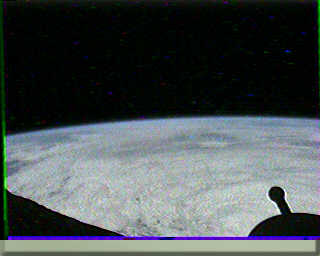
![]()
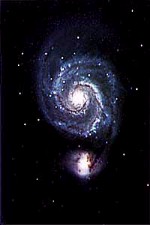
Internal view of Mir received on June 26, 1999.

![]()
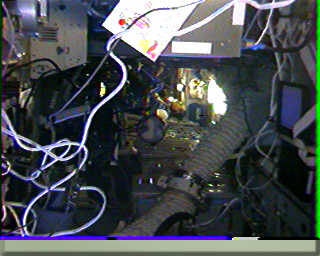
This is a
picture looking at one of the solar
panel arrays with the earth in the background.
This was received on 2 meters using a SSTV
program called Chromapix.
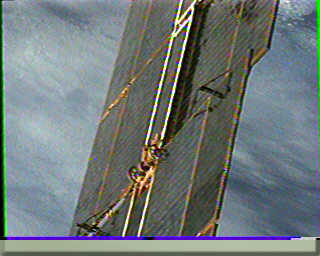
![]()

Here
is another picture sent by the MIR
Space Station and received on 2 meters.

![]()
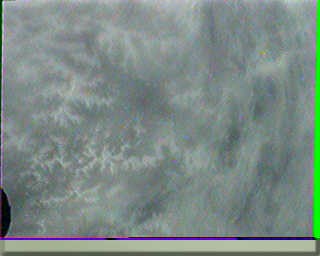
This
was transmitted by the MIR Space
Station on New Year's Day 1999 on the
2 Meter band and copied by VE6EGN.
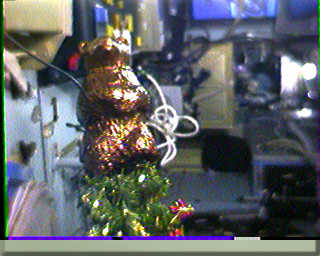
![]()

Received
on the morning of March 5,
1999 by VE6EGN using Chromapix.

![]()
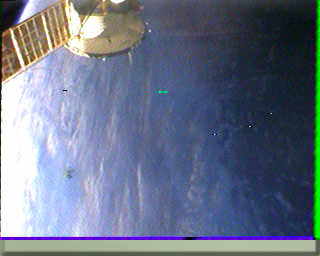
For more information on using SSTV, (Slow Scan TV), see the SSTV page.
AO-27 is a very popular satellite available to amateur radio operators. This satellite operates as an orbiting FM repeater. Due to some technical difficulties this satellite is normally made available for use during daylight hours only. The uplink for this satellite is on VHF (2 Meters) and the downlink is on UHF (70 cm). The satellite receiver is extremely sensitive and can be worked with very low power and simple antenna systems. Many ham operators have worked this satellite with a pair of handheld transceivers (VHF and UHF) using the small standard handheld antennas. For more information on the operating schedule of AO-27, check the following Schedule Link.
AO-27 Spacecraft Information
Name:
AMRAD-OSCAR 27 aka EYESAT-1
NASA Catalog Number: 22825
Launched: September 26, 1993
Launch vehicle: Ariane 4
Launch location: Kourou, French Guiana
Weight: 11.8 kg
Orbit: Polar LEO (Low Earth Orbit)
Inclination: 98.5 degrees
Size: 150 x 150 x 150 mm
Period: 101 Minutes
Uplink:
Downlink:
Features:
While you're here.....
Check out some of the recently released Hubble Space Telescope Images at the Space Telescope Science Institute Website.
Then there's.....
Nasa's Website. Keep up to date with the latest activities at NASA.
Have a look at.....
The Jet Propulsion Laboratory (JPL) Website. This is an excellent site for keeping up to date with the latest activities at JPL and NASA.
How about.....
Building your own Dobsonian Telescope.
(Click on E.T. Above)
Check out the following links for an excellent description of the amateur satellites and a description of the equipment required. You will also find some downloadable tracking software. There are several "FREEWARE" programs available.

Ham Sat Links
